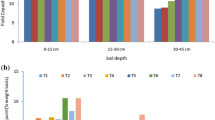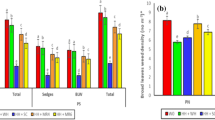Abstract
Green manuring of rice with dhaincha (Sesbania aculeata) is widely practised under irrigated puddle-transplanted conditions. In flood-prone lowlands, the rice is established through direct seeding early in the season and flooding occurs after 1–2 months of crop growth following regular rains. The low yields are due to poor crop stands and difficulty in nitrogen management under higher depths of water. The effect of green manuring with dhaincha intercropped with direct-seeded rice vis-à-vis the conventional practice of incorporating pure dhaincha before transplanting was investigated under flood-prone lowland conditions (up to 50–80 cm water depth) at Cuttack, India. Treatment variables studied in different years (1992, 1994 and 1995) were: rice varieties of different plant heights, crop establishment through direct seeding and transplanting, varying length of periods before dhaincha incorporation, and urea N fertilizer levels. Dhaincha accumulated 80–86 kg N ha-1 in pure stand and 58–79 kg N ha-1 when intercropped with direct-seeded rice in alternate rows at 50 days of growth. The growth of rice improved after dhaincha was uprooted manually and buried in situ between the rice rows when water depth was 10–20 cm in the field. The panicle number was lower but the panicle weight was higher with dhaincha green manuring than with recommended level of 40 kg N ha-1 applied as urea. The grain yield was significantly higher with direct seeding than with transplanting due to high water levels (>60 cm) immediately after transplanting. Dhaincha manuring was at par with 40 kg N ha-1 as urea in increasing the yield of direct-seeded and transplanted crops. The highest yield of direct-seeded crop was obtained when 20 kg N ha-1 was applied at sowing and dhaincha was incorporated at 50 days of growth. The results indicate that green manuring of direct-seeded rice with intercropped dhaincha is beneficial for substituting urea fertilizer up to 40 kg N ha-1 and augmenting crop productivity under flood-prone lowland conditions.
Similar content being viewed by others
References
Fujisaka S, Ingram KT & Moody K (1991) Crop establishment (beusani) in Cuttack district, India. IRRI Res Paper Ser No 148. IRRI, Manila, Philippines
IRRI (1993) Rice Almanac. IRRI, Manila, Philippines
Islam Z & Karim ANMR (1997) Whiteheads associated with stem borer infestation in modern rice varieties: an attempt to resolve the dilemma of yield losses. Crop Prot 16(4): 303–311
Manna GB, Jha KP & Rao KS (1988) Potentiality of green manuring practice in the current rice production strategy. In: Dutta SK & Sloger C (eds) Biological Nitrogen Fixation Associated with Rice Production, pp. 329–335. Oxford Univ Press and IBH Publ Co, New Delhi
Moorthy BTS & Rao KS (1991) Influence of method of stand establishment and cultural and weed-control practices on performance of rainfed lowland rice (Oryza sativa) in coastal Orissa. Indian J Agri Sci 61: 588–590
Panda D, Samantray RN, Mohanty SK & Patnaik S (1988) Green manuring with Sesbania aculeata – its role in nitrogen nutrition and yield of rice. In: Dutta SK & Sloger C (eds) Biological Nitrogen Fixation Associated with Rice Production, pp. 305–313. Oxford Univ Press and IBH Publ Co, New Delhi
Pande HK & Reddy BB (1984) Rice cultivation systems in waterlogged and flood-prone areas. In: Deepak A & Rao KR (eds) Applications of Remote Sensing for Rice Production, pp. 127–140. A Deepak Publ, Virginia, USA
Reddy BB, Ghosh BC & Panda MM (1985) Flood tolerance of rice at different growth stages as affected by fertilizer application. Plant Soil 83: 255–263
Reddy MD & Panda MM (1988) Effect of methods of stand establishment on grain yield of rice under intermediate deepwater conditions (15– 50 cm). J Agri Sci Camb 110: 47–51
Rubia EG, Hoeng KL, Zalucki M, Gonzales B & Norton GA (1996) Mechanisms of compensation of rice plants to yellow stem borer (Scirpophaga incertulas Walker) injury. Crop Prot 15(4): 335–340.
Sharma AR (1992) Adverse effects of beushaning on intermediate deepwater rice (DWR). Intl Rice Res Newsl 17(2): 21–22
Sharma AR (1994a) Fertilizer management in rainfed lowland rice under excess water conditions. Fert News 39(5): 35–44
Sharma AR (1994b) Effect of different methods and timings of stand establishment on performance of rainfed lowland rice under 0– 50 cm water depth. J Agron Crop Sci 172: 38–51
Sharma AR (1995) Direct seeding and transplanting for rice production under flood-prone lowland conditions. Field Crops Res 44: 129–137
Sharma AR & Das KC (1994) Effect of green manuring with dhaincha (Sesbania aculeata) on growth and yield of direct-sown and transplanted rice under intermediate deepwater conditions (0– 50 cm). J Agri Sci Camb 122: 359–364
Sharma AR & Ghosh A (1998) Optimum seed rate and nitrogen fertilizer requirement of rice under semi-deepwater ecosystem. J Agron Crop Sci 181: 167–172
Sharma AR & Mittra BN (1988) Effect of green manuring and mineral fertilizer on growth and yield of crops in rice-based cropping on acid lateritic soil. J Agri Sci Camb 110: 605–608
Sharma AR & Rao MJ Balakrishna (1993) Yield performance and tolerance of rice (Oryza sativa) to stem-borer (Scirpophaga incertulas) under intermediate and semideep-water conditions. Indian J Agri Sci 63: 649–651
Sharma AR & Reddy MD (1991) Performance of different height rice lines under intermediate deep water levels. Intl Rice Res Newsl 16(5): 8–9
Singh Y, Singh B & Khind CS (1991) Efficient management of leguminous green manures in wetland rice. Adv Agron 45: 135–189
Author information
Authors and Affiliations
Rights and permissions
About this article
Cite this article
Sharma, A., Ghosh, A. Effect of green manuring with Sesbania aculeata and nitrogen fertilization on the performance of direct-seeded flood-prone lowland rice. Nutrient Cycling in Agroecosystems 57, 141–153 (2000). https://doi.org/10.1023/A:1009863100224
Issue Date:
DOI: https://doi.org/10.1023/A:1009863100224




